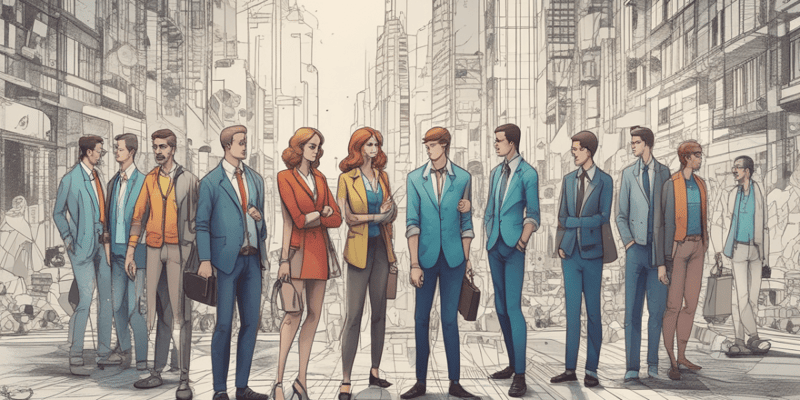Questions and Answers
Which type of group is defined by the organization's structure and has designated work assignments and specific tasks?
Formal groups
Which type of group occurs naturally in the workplace and tends to form around friendships and common interests?
Informal groups
What is the main purpose of project teams?
To work on specific projects or initiatives
Which type of group is composed of individuals from different departments or functional areas who collaborate to address complex issues or projects that require diverse expertise?
Signup and view all the answers
What is the role of management teams within an organization?
Signup and view all the answers
Which type of group is formed to provide guidance and recommendations on specific organizational matters?
Signup and view all the answers
What is the definition of a group?
Signup and view all the answers
Which type of group is a team of employees within a department who work together to achieve departmental goals?
Signup and view all the answers
What is the main characteristic of informal groups?
Signup and view all the answers
Which type of group is formed to work on specific projects or initiatives?
Signup and view all the answers
Which psychologist introduced the model of group development stages?
Signup and view all the answers
During which stage of group development do conflicts and disagreements arise?
Signup and view all the answers
What happens during the norming stage of group development?
Signup and view all the answers
Which stage marks the end of the group's life cycle?
Signup and view all the answers
What is the purpose of understanding group development stages?
Signup and view all the answers
What is social influence in the context of group behavior?
Signup and view all the answers
What do norms do within a group?
Signup and view all the answers
What is the role of leadership in a group?
Signup and view all the answers
What is group cohesion?
Signup and view all the answers
Do all groups progress through the stages of group development in a linear fashion?
Signup and view all the answers
Which of the following best describes social loafing?
Signup and view all the answers
What is groupthink?
Signup and view all the answers
What is conflict in the context of group behavior?
Signup and view all the answers
What is group identity?
Signup and view all the answers
What does social identity theory posit?
Signup and view all the answers
What are social norms?
Signup and view all the answers
Which of the following can lead to flawed decisions and a lack of creativity?
Signup and view all the answers
What is the potential impact of conflict in a group?
Signup and view all the answers
How can social norms influence individual behavior within a group?
Signup and view all the answers
In what settings are these concepts of group behavior applicable?
Signup and view all the answers
Study Notes
Types of Groups
- A formal group is defined by the organization's structure and has designated work assignments and specific tasks.
- An informal group occurs naturally in the workplace and tends to form around friendships and common interests.
- A departmental group is a team of employees within a department who work together to achieve departmental goals.
- A cross-functional team is composed of individuals from different departments or functional areas who collaborate to address complex issues or projects that require diverse expertise.
- A project team is formed to work on specific projects or initiatives.
- An advisory group is formed to provide guidance and recommendations on specific organizational matters.
- A management team's role is to manage and oversee the operations of an organization.
Group Development Stages
- A psychologist, Bruce Tuckman, introduced the model of group development stages.
- The stages of group development are: forming, storming, norming, performing, and adjourning.
- During the storming stage, conflicts and disagreements arise.
- During the norming stage, the group develops a sense of trust and cooperation.
- The adjourning stage marks the end of the group's life cycle.
- Understanding group development stages helps to facilitate effective teamwork and minimize potential conflicts.
Group Behavior
- Social influence refers to the process by which group members influence one another's behavior, attitudes, and opinions.
- Norms are the unwritten rules that govern a group's behavior and are enforced through social pressure.
- Leadership plays a crucial role in a group, influencing group behavior and decision-making.
- Group cohesion refers to the bonds and relationships among group members.
- Social identity theory posits that individuals derive a sense of identity and belonging from their group memberships.
- Social norms are shared expectations and standards that guide group behavior.
- Groupthink is a phenomenon where a group prioritizes consensus over critical thinking, leading to flawed decisions.
Conflict and Decision-Making
- Conflict in the context of group behavior refers to disagreements and opposition between group members.
- Social loafing occurs when individuals exert less effort in a group setting than they would individually.
- Groupthink can lead to flawed decisions and a lack of creativity.
- Conflict can have a positive impact on a group, stimulating creativity and innovation.
- Social norms can influence individual behavior within a group, either positively or negatively.
Applicability
- The concepts of group behavior are applicable in various settings, including workplaces, communities, and social organizations.
Studying That Suits You
Use AI to generate personalized quizzes and flashcards to suit your learning preferences.
Description
Test your knowledge on group development and dynamics with this quiz. Learn about the stages that groups go through and the differences between formal and informal groups. Challenge yourself and enhance your understanding of group dynamics.




